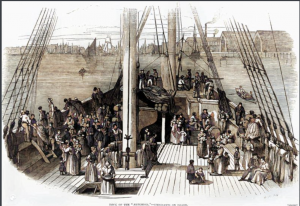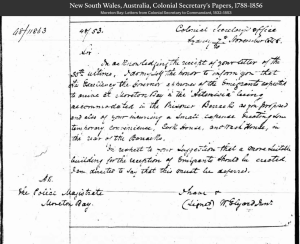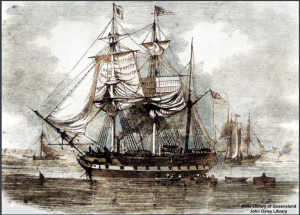The Artemisia
This vessel was first named England’s Queen and launched on 11 October 1847 from Mr Richard Wilkinson’s Yard, Sunderland. Then somewhere between the movement from Sunderland to the East India Docks she was renamed Artemisia. The name Artemisia is of Greek origin and refers to the Moon Goddess and Safety.
On her maiden voyage this vessel was the first to travel with free immigrants from Britain to arrive in Moreton Bay. The Artemisia sailed from London with around 209 immigrants, stopping at Plymouth where she took on a further 31 passengers. Owned by Anthony Ridley and under the captaincy of John Prest Ridley she left Plymouth on 18 August 1848.
Project
Perhaps the detail of a letter written by Captain John Clements Wickham (Police Magistrate in Brisbane) to Francis Merewether (Immigration Agent) rings true for what I proposed. “Of all the Wild Schemes … this seems to be the wildest"! To research the Artemisia and follow her passengers (over 200 of them) is a mammoth project! There were a quite few challenges! This project reconstructs the lives of passengers by using all the familiar genealogical and historical data, plus the public record. Some interesting stories, challenges, strands, interactions, and interconnectedness have emerged. This extensive research shows how traditional stereotypes and generalisations can be challenged, the historical lens can shift, and exciting new themes may emerge.
Barque or Barquentine
Contemporary texts state she was a barquentine of 492 tons (558 tonnes burthen) built at Sunderland in 1847. It would appear from the illustrations that she was a 3-masted vessel with fore and aft sails on the rear mast, and therefore a barque, but this status has recently been challenged casting doubt on the observations of the illustrators. The image shows the mainmast as being square-rigged rather than gaff-rigged. She is also recorded in Lloyd’s Register as a barque from 1848/49 through to 1854/55 and not mentioned again after 1855. Built in Sunderland, she was moved to the East India Docks in London. She was owned by Anthony Ridley, a subscriber in Lloyd’s Register of Shipping. John Prest Ridley, Anthony’s nephew, served as the vessel’s captain from 1848 through to 1853. Captain Samuel Banes then commanded her until her demise.
The First Voyage
A journalist from the Illustrated London News wrote that the Artemisia was ‘a fine ship’, all ‘spic and span new’. The newspaper felt it unnecessary to describe the interior of the vessel, the ‘arrangement of the ship chartered by the Commissioners is generally the same’. The upper deck was ‘handsomely fitted, so as to accommodate passengers of the better class’. Here the reporters ‘tasted the provisions for the emigrants, the biscuits, beef, and port, and found them of excellent quality’. They ‘now inspected the accommodation between decks, where a number of the passengers were seated some playing with their children, others reading’, a mixture of excitement and sadness. ‘By and by came the dinner - the meat well cooked and of good quality; though of course, the table had not all the snugness of the cottage meal. The parties were in “ messes” of six or eight individuals ; and the comfort of the voyage is much studied by berthing near each other those who come from the same part of the country, and messing as nearly as possible those who are friends. The great order maintained on board is also indicated by the “Regulations” and “ Dietary Scales” hung up in conspicuous places between decks.’

Image of the deck of the Artemisisa from the Illustrated London News, John Oxley Library
‘Towards evening’ they wrote, ‘the Artemisia made ready to sail; our artist has represented the fine ship getting under way, fore-topsails set, and heaving up anchor, &c. She was next taken in tow by a steam-tug to Gravesend; we proceeded in her a short distance, and then, with the heartiest wishes for a safe voyage, we bade adieu to the new ship freighted with so many anxious souls.’
After leaving London and then Plymouth in 1848 she arrived at Moreton Bay via Launceston, Tasmania and Sydney, NSW, on 13 December. The barque was too large to cross the bar at the mouth of the Brisbane River, so that the first free immigrants to Brisbane, (around 240 of them) were transferred to the Raven and put ashore. The settlers comprised around 47 married couples (94 persons), 32 male children, 8 infants under 12 months, 28 females between 1-14, 42 single men and 20 single women.
Reverend John Dunmore Lang
The Artemisia delivered a letter to inform the inhabitants of Moreton Bay of the imminent arrival of a second vessel carrying free immigrants to the northern district. Arriving close on the heels of the Artemisia in January 1849, the Fortitude was the first of a fleet of three of Dr. John Dunmore Lang’s enterprises: Fortitude; Chasely; and Lima. The Moreton Bay Courier reported that ‘The “Artemisia” brought news that the first of Dr. Lang’s ships, the “Fortitude”, was to leave London direct for Moreton Bay on the 6th September.’ The journey then took about four months to complete the result being that the Fortitude arrived in Moreton Bay in January 1849.
Further Voyages
The Artemisia regularly served the London to New South Wales route from 1848 to 1853, China 1853 to 1854 and Australia again in 1854 to 1855. She carried cargoes such as bales of wool back to England. On 10 January 1849 on her return voyage to England she left Moreton Bay and sailed to Sydney where, after stopping over until 15 March 1849, she was loaded with a cargo that included 1479 bales of wool.
Her second trip to the Antipodes saw her leave London on 5 September 1849 via Plymouth arriving in Sydney on 27 December 1849. She then sailed to Port Stephens (Newcastle), landing iron and machinery for the Australian Agricultural Company coal mine. The AACo was established as a land development company in 1824 with the assistance of a British Parliament Crown Grant of one million acres in the Port Stephens region of New South Wales. The Artemisia also then disembarked 40 passengers from England.
Her return trip meant she was in Sydney on 7 February 1850 before leaving for the Auckland Islands and Wellington, New Zealand. From there, on 19 May 1850 Artemisia sailed to San Francisco, America, arriving on 5 August 1850 after being on the seas for 74 days. Leaving San Fransisco, via Honolulu, she arrived again in Sydney on 12 December 1850 with timber from New Zealand still in her cargo. On 16 March 1851 she left Sydney for San Francisco, again via Honolulu and managed the return trip 20 July 1851 with a few passengers and 23 in steerage, arriving again in Sydney 20 September 1851. Towards Christmas 1851 on the 19 December she left Sydney for Mauritius - it was presumed for a voyage to London. John Prest Ridley commanded her until 1853 when he travelled to North and South New Zealand. Ridley then became Master of the Ship Adamant.
The Crew
Captain Samuel Banes 1854
Captain Samuel Banes took over command of the Artemisia and it had arrived back in Auckland, New Zealand on the 4 April 1854. It then left for Guam on 5 June 1854 in ballast. At an unknown date the Artemisia bilged on the east side of Kangean Island, Java Sea, Indonesia. She was most likely plundered by locals and became a total wreck. Captain Samuel Banes along with his wife and 23 crew arrived safely at Sourabaya, East Java, in a ship’s boat on 30 July 1854 and told of the shipwreck.
Dr George Kingston Barton
surgeon on board the Artemisia 1848.
http://www.eurekapedia.org/George_Barton
Is Dr George Barton a brother to Frederick James Barton (Medical Officer of Brisbane Hospital 1851-1863)
Frederick was born 19 June 1826, Ireland, and died 30 August 1863 at his post at Brisbane Hospital, aged around 37
The parents of Frederick Barton were John Barton and Elizabeth Beck. It is unknown as yet who the parents of George Barton were.
His brother Albert BARTON was in Brisbane. (1828- 23 Feb 1864, Brisbane)
Frederick Barton married in 1855 in Ipswich, Moreton Bay County of Stanley, NSW to Susan Elizabeth Frances WARRY (1 Feb 1834 Miserton, Somerset- 8 Nov 1903 Queensland)
Frederick Barton died on 31 August 1863 Queensland and was buried in Paddington Cemetery, Milton, Brisbane City.
Children of Frederick and Susan Barton:
Florence BARTON born 14 July 1857, Brisbane
Amy Symes BARTON born 20 June 1859 Brisbane and died 10 July 1913, Queensland
Paul BARTON Born 2 April 1861 Brisbane and died 14 August 1861 Brisbane
Elizabeth Ella BARTON Born 18 June 1862 Brisbane and died 2 Feb 1864 Brisbane
Daughters Amy and Florence BARTON
Born and lived in a stone house at the corner of North Quay and Ann Streets, the site of the general hospital and present site of the Supreme Court. Step father after the death of Frederick James Barton was Dr Hugh Bell and lived Milton Road.
The First Free Government Assisted Immigrants to Moreton Bay
There were 246 free settlers that emigrated on the Artemisia that disembarked at Moreton Bay between 13 and 16 December 1848. Provisions were hardly ideal for them, as Captain John Clements Wickham, Police Magistrate of Brisbane intimated in his letter to Francis Merewether. A sentiment echoed in the pages of the Letters from the Colonial Secretary W. Elyard Junr. dated November 1848 to the Police Magistrate, Moreton Bay.

Letter from Colonial Secretary to Police Magistrate John Clements Wickham, dated November 1848, Moreton Bay: Letters from Col Sec to Commandant, 1832-1853, NSW Archives, 48/11863
Colonial Secretary's Office
Sydney 7/20 November 1848
Sir,
In acknowledging the receipt of your letter of the 30th ultimo, I do myself the honor to inform you that His Excellency the Governor approves of the Emigrants expected to arrive at Moreton Bay in the 'Artemisia' being accommodated in the Prisoner Barracks as you proposed and also of your incurring a small expense Erecting? from temporary convenience, Cook House and Wash House, in the rear of the Barracks.
In respect to your suggestion that a more suitable building for the reception of Emigrants should be erected I am directed to say that this must be deferred.
More on the Artemisia and its passengers can be found at the link below.
http://www.eurekapedia.org/Artemisia
